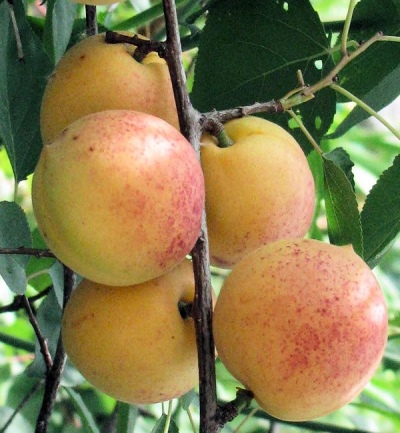
- Tree height, m: 4,5
- Fruit weight, g: 60
- Skin : thin
- Fruit color: orange, blush in some places
- Pulp (consistency): hard, juicy
- Fruit taste: gorgeous, sweet and sour
- Separability of the bone from the pulp: light
- Appointment: universal
- Fruiting period: in the second half of July
- Yield: high
Apricot Moskovsky is a candidate for cultivation in unfavorable conditions of a temperate climate, which will generously thank the owner of a plot of any area in central Russia and the Central Black Earth Region. Until recently, it was believed that apricot can be grown only in the southern regions, but domestic breeders refuted this delusion with a number of magnificent samples - winter-hardy, with excellent yields and excellent taste.
Description of the variety
Apricot Moskovsky is invariably included in the rating of the best varieties for growing in Moscow and the Moscow region. Some incompetent authors are sure that this is not the name of one beautiful and undeservedly ignored species by gardeners, but a general collective term for a collection bred for specific climatic conditions.
But this is a productive and unpretentious hybrid that deserves to be in the collection of every gardener who grows this exotic fruit not in the south, but in cold climates, with long winters and short summers.
Like other varieties of the rating for the capital region, it has significant advantages:
suitable for growing in cold climates, with medium winter hardiness;
drought resistant, unpretentious in care and soil;
with high yields and large fruits;
universal purpose - for eating fresh and preparations for the winter;
perfectly tolerates transportation and storage in optimal conditions, while maintaining its presentation.
The peculiarities of the variety not only make it a good choice for planting in the Moscow region, but also suggest the possibility of breeding in other regions with similar climatic conditions. It can be grown for your own needs, with the aim of generating commercial profits. The self-fertility of the variety suggests that it is pollinated on its own, but if there are apricots with a similar flowering period nearby, the yield can be increased.
Fruit characteristics
Normally, the fruit reaches 50-60 g, but experienced gardeners increase the size, creating optimal conditions for the tree and thinning the amount in especially fruitful years:
dense fibrous pulp filled with juice;
the skin is thin, and the stone is medium in size and easily peels off;
fruit sugars and acids, vitamins and microelements - a sufficient amount, they are preserved during heat treatment.
Compotes, jams and preserves made from fruits that retain their aroma and shape are a great help for immunity in cold climates with long winters. Large, round, bright orange, sun-toasted fruits will please even the most picky apricot connoisseurs.
Taste qualities
The taste is pronounced, with a slight sourness, absolutely no bitterness, retains its characteristics in preparation, therefore it is often used in baking. Dense pulp retains its shape during heat treatment, thin skin is practically not felt. The presentable appearance makes the variety popular with buyers, and the pleasant sourness adds piquancy and makes the Moskovsky apricot recognizable among other varieties recommended for growing in temperate climates.
Ripening and fruiting
Fruits appear in abundance in 4 years from the moment of planting, earlier fruiting is insignificant, and it is better to partially remove it so that the tree does not waste energy on it, but grows in height. In addition, the first small harvests do not have any special taste. The timing of flowering and ripening depends on the area - in gardeners' reviews, they vary from late April to mid-May, from late July to the second decade of August.
A cold summer can delay the production of orange fruits by 1-2 weeks.

Yield
Apricot Moskovsky belongs to varieties with high yields, you can get 30-35 kg of fruits from one tree. From the 4th year of cultivation, it gives stable fruiting annually. The creation of optimal conditions and the proximity of other trees with a similar flowering period allows you to increase the indicators and prevent crushing of the fruits. This is the subtlety of handling any apricot tree, although the variety is self-fertile.
Growing and care
Choosing a sunny side, sheltered from cold air currents, loam or sandy loam (soil with good aeration) for planting a tree purchased from a nursery with a proven reputation, you need to provide the plant with optimal care. Little effort is required from the gardener - periodic watering, loosening the soil after natural precipitation, three times the application of top dressing per season. This will help to get a generous return from the Moscow apricot. The main thing is not to forget to prune in time, mulch the soil for the winter and cover the branches if severe frosts are indicated in the long-term weather forecast. By choosing this variety, any gardener will be satisfied for many years.



































































